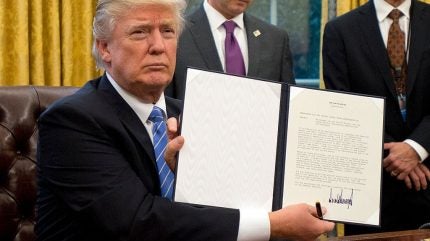

In June 2016, having defeated his rivals for the Republican presidential nomination, Donald Trump took to a Pennsylvania factory floor. “Skilled craftsmen and tradespeople and factory workers have seen the jobs they love shipped thousands and thousands of miles away,” he said.
Trump promised to renegotiate the North American Free Trade Agreement (Nafta) with Mexico and Canada, and to scrap the Trans-Pacific Partnership (TPP), which had stalled under Barack Obama. The past three decades have seen a gradual erosion of manufacturing jobs in the US, with many being offshored to lower-wage economies such as Mexico and China.
Four years later, how has Trump reshaped US’s relationship with foreign direct investment (FDI)?
Trump and the treaty negotiations
Trump entered the White House with the unenviable task of defending the US from a $15bn investor lawsuit. Obama had cancelled a planned oil pipeline between the US and Canada, citing its incompatibility with the US’s carbon emissions reduction targets. Claiming unfair treatment, the pipeline’s Canadian operator, TransCanada, sued the US through investor-state dispute settlement (ISDS).
I think the tax cuts on the whole were favourable, and I would expect that if Trump had stopped there, we would have had more inward investment. Gary Hufbauer, Peterson Institute for International Economics
How well do you really know your competitors?
Access the most comprehensive Company Profiles on the market, powered by GlobalData. Save hours of research. Gain competitive edge.
 Company Profile – free sample
Company Profile – free sampleThank you!
Your download email will arrive shortly
Not ready to buy yet? Download a free sample
We are confident about the unique quality of our Company Profiles. However, we want you to make the most beneficial decision for your business, so we offer a free sample that you can download by submitting the below form
By GlobalData
Under ISDS, foreign investors can sue their host government over breaches of their treaty rights, which are typically broad and ill-defined. ISDS cases take place in an international tribunal, with arbitrators unconstrained by either domestic law or investment law precedent.
On his first Monday in office, Trump resolved the TransCanada case by reversing Obama’s decision, allowing the pipeline to go ahead.
Then, on Tuesday, Trump ordered the US’s withdrawal from the TPP – effectively the largest investment agreement ever negotiated, which would have represented 40% of the world’s economy. The TPP would have introduced or dramatically strengthened ISDS provisions with Australia and Japan, the fifth and sixth-largest non-tax haven recipients of US FDI.
Lighthizer attacks ISDS
Trump would soon appoint a trade representative, Robert Lighthizer, steadfastly opposed to ISDS. “I am always troubled by the fact that non-elected, non-Americans can make a decision that a US law is invalid,” Lighthizer told a Senate Finance Committee hearing. “Just as a matter of principle, I find that offensive.”
As well as his principled objections, Lighthizer shared Trump’s concern that investor protection was encouraging US companies to expand their operations abroad at the expense of US workers.
[Keep up with Investment Monitor: subscribe to our weekly newsletter]
While Trump was able to pacify TransCanada, the US-Canada ISDS relationship remained the most frequently litigated in the world. When it came time to fulfil Trump’s promise of renegotiating Nafta, Lighthizer pushed for ISDS reform against business opposition, eventually securing the elimination of ISDS between the US and Canada.
However, ISDS between the US and Mexico was largely kept in place for the sectors most likely to use it – energy, utilities and infrastructure. Moreover, the termination of Nafta was subject to a three-year survival clause. Even if Biden fulfils his promise to cancel Keystone XL, TransCanada will still be able to sue until 2023.
Trump’s China trade wars
Trump has also embarked upon trade wars with Mexico, the EU, Canada and, most fiercely, China.
By the time of Trump’s inauguration, the US and China were close to completing negotiations on a bilateral investment treaty. While his administration initially supported a resumption of the negotiations, cooperation soon gave way to confrontation.
In August 2020, the US launched an investigation of China’s trade practices. A particular focus of criticism was China’s requirement that investors share their technology with Chinese companies. Intended to encourage productivity spillovers, technology transfer requirements have been a key plank of China’s development strategy.
Punitive tariffs followed, resulting in retaliatory measures by China. The US also led a lobbying offensive against Chinese investors, threatening to ban TikTok and, most notably, leaning on allies to cancel sensitive contracts with Huawei. While a partial agreement was reached in January 2020, the conflict has rumbled on.
FDI in the US under Trump
Trump’s aggressive postures towards major investor states and his emphasis on reducing the US’s trade deficit suggested that attracting FDI was not a priority for the administration.
Inward capital flows such as FDI can appreciate a country’s currency, reducing the competitiveness of its exports. One OECD study found that each dollar of FDI received increases a country’s trade deficit by $0.82.
However, the number and value of inward greenfield FDI projects has risen slightly under Trump. Greenfield investment brought $269bn into the country during Trump’s first three years, compared with $218bn under the first three years of each Obama term, according to the UN.
The annual value of inward mergers and acquisitions (M&A) has fallen by more than half since Trump took office (57%), although this is mainly due to a decline in high-value deals. The number of M&A deals has fallen by a comparatively small 11%.
The surge under Obama and subsequent decline under Trump is partly attributable to Chinese investment – specifically M&A, which account for 92% of US FDI inflows from China, according to the Rhodium Group.
One reason why inward FDI may not have fallen as much as expected is the Trump administration’s enormous corporate income tax cut in 2017, from 35% to 21%. Such a large cut to corporate tax rates would, in normal times, have been expected to lead to a surge in greenfield FDI inflows – albeit without necessarily boosting employment or wages.
“I think the tax cuts on the whole were favourable, and I would expect that if he had stopped there, we would have had more inward investment,” says Gary Hufbauer, a senior fellow at the Peterson Institute for International Economics. “But the other side of his policies was pretty unfavourable, and created a lot of business chaos.”
US investment abroad
More central to Trump’s economic strategy, however, has been the end of outsourcing and bringing US capital back home. US investment abroad increased by just $80bn during Trump’s first three years in office, according to the US Bureau of Economic Analysis – an almost total collapse compared with previous administrations.
However, this change was not driven by investment in China. While US investment in China has been much lower under Trump than during Obama’s second term, it has remained higher than that seen in the first three years of other recent administrations.
The apparent collapse of US direct investment abroad is, in reality, an artefact of imperfect data. Greenfield investments, which most closely align with the public understanding of FDI, actually increased slightly during the Trump administration, as did M&A.
The apparent decrease in US investment abroad is, instead, the result of corporate tax avoidance. Before Trump, US multinationals were only taxed on profits if they brought them back home, incentivising US corporations to amass profits of more than $2trn in offshore tax havens.
In 2017, Trump’s Tax Cuts and Jobs Act overhauled this system, implementing a one-time tax on all profits held abroad and replacing the repatriation tax with a tax on all US profits, wherever they are held.
This led to a rush of profits back into the US. Although less than Trump’s optimistic estimate of $4trn, the repatriated profits did add up to $1trn by the end of 2019. The countries or regions reporting the greatest fall in US investments in 2018 were not China and Mexico, but Bermuda ($199bn) and the British Caribbean ($162bn).
It was this mass repatriation of cash from tax haven holding companies that fuelled the apparent collapse in US foreign investment under Trump, not a reduction in capital expenditures. While such flows are recorded as FDI in official statistics, they are much more similar to portfolio investments.
Whether the sudden change in outward investment was the result of forgone capital expenditures or profit repatriation, what mattered to the Trump administration’s economic agenda was that it would translate into a rise in domestic investment.
While domestic private investment had gradually recovered from the financial crisis throughout most of Obama’s tenure, it stagnated during his final two years. Growth in domestic investment resumed just as Trump was taking office, but began to stall again at the start of 2019.
The windfall from Trump’s tax changes was channelled not into productive investment, but share buy-backs and dividends, a surge that was not matched by any substantial surge in capital expenditures.
Why tax cuts don’t lead to more investment
The failure of the tax cuts to spur investment was predictable. In 2004, the Bush administration similarly attempted to usher the US’s foreign profits back home through a tax incentive. While an estimated $312bn flowed back into the US, up to 91% of this was spent on share buybacks.
“What happened was that the US companies that have a significant stash of money abroad basically used this opportunity to push up the value of their shares,” says Simeon Djankov, a researcher at the Peterson Institute of International Economics.
“The large US tech firms, if you look at the past few years, their stock has improved significantly, in part because of these buybacks,” he adds. “It does not help the people in terms of jobs and so on, as the Trump presidency has said. Ironically, it helps the richer people – because who has these stock market portfolios? It is the richer people.”
Trump has not managed to stem the outflow of US capital to China and Mexico. Instead, the administration offered tax breaks to multinationals that had stashed their profits offshore, hoping that this repatriated cash would be ploughed into creating jobs at home. In the end, shareholders pocketed the cash, leaving domestic investment to stagnate.
Four years after his speech to the Pennsylvania factory workers, Trump has managed to bring back capital to US shores – but not in the way many in the audience would have hoped.




